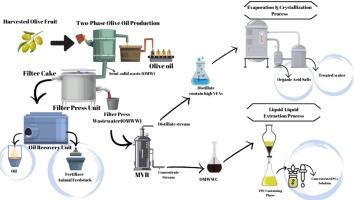重新定义废物:可持续管理橄榄油厂废料以回收酚类化合物和有机酸
IF 6.3
2区 工程技术
Q1 ENGINEERING, CHEMICAL
引用次数: 0
摘要
橄榄油工业会产生大量的橄榄油厂废料(OMW),由于其有机负荷和酚类含量较高,给环境带来了挑战。本研究探讨了一种生态友好型方法,通过综合工艺回收有价值的酚类化合物 (PC) 和挥发性脂肪酸 (VFA),从而管理 OMW。该方法包括使用压滤机,然后使用自清洁机械蒸汽再压缩(SCMVR)工艺分离水和挥发性化合物,最后使用液-液萃取工艺提取多氯联苯。99% 的挥发性脂肪酸以有机酸盐的形式从 SCMVR 蒸馏液中回收,并利用 X 射线衍射 (XRD) 分析对其进行了表征。考虑到溶剂类型、pH 值、温度和萃取时间等变量,采用响应面方法(RSM)的箱-贝肯设计(BBD)对萃取工艺进行了优化。通过液-液萃取工艺和两级萃取工艺,多氯联苯的回收率达到 98%,其中包括经 LC-MS/MS 鉴定的香草酸、咖啡酸、油菜素、香豆素和没食子酸等主要酚类物质。这项研究强调了将橄榄油厂废弃物转化为宝贵资源、促进可持续发展实践以及支持橄榄油行业循环经济的潜力。本文章由计算机程序翻译,如有差异,请以英文原文为准。

Redefining the waste: Sustainable management of olive mill waste for the recovery of phenolic compounds and organic acids
The olive oil industry generates significant amounts of olive mill waste (OMW), which poses environmental challenges due to its high organic load and phenolic content. This study investigates an eco-friendly approach to managing OMW by recovering valuable phenolic compounds (PCs) and volatile fatty acids (VFAs) through an integrated process. The methodology involves a filter press, followed by a self-cleaning mechanical vapor recompression (SCMVR) process for water and volatile compounds separation, and a subsequent liquid-liquid extraction for PCs. 99 % of the VFAs were recovered as organic acid salts from the SCMVR distillate and characterized using X-Ray diffraction (XRD) analysis. The Box-Behnken design (BBD) of response surface methodology (RSM) was used to optimize the extraction process, considering variables such as solvent type, pH, temperature, and extraction time. The liquid-liquid extraction process yielded a 98 % recovery of PCs with two-stage extraction process, including key phenolic species such as vanillic acid, caffeic acid, oleuropein, coumaric acid and gallic acid, identified by LC-MS/MS. This study highlights the potential for converting olive mill waste into valuable resources, promoting sustainable practices, and supporting a circular economy in the olive oil industry.
求助全文
通过发布文献求助,成功后即可免费获取论文全文。
去求助
来源期刊

Journal of water process engineering
Biochemistry, Genetics and Molecular Biology-Biotechnology
CiteScore
10.70
自引率
8.60%
发文量
846
审稿时长
24 days
期刊介绍:
The Journal of Water Process Engineering aims to publish refereed, high-quality research papers with significant novelty and impact in all areas of the engineering of water and wastewater processing . Papers on advanced and novel treatment processes and technologies are particularly welcome. The Journal considers papers in areas such as nanotechnology and biotechnology applications in water, novel oxidation and separation processes, membrane processes (except those for desalination) , catalytic processes for the removal of water contaminants, sustainable processes, water reuse and recycling, water use and wastewater minimization, integrated/hybrid technology, process modeling of water treatment and novel treatment processes. Submissions on the subject of adsorbents, including standard measurements of adsorption kinetics and equilibrium will only be considered if there is a genuine case for novelty and contribution, for example highly novel, sustainable adsorbents and their use: papers on activated carbon-type materials derived from natural matter, or surfactant-modified clays and related minerals, would not fulfil this criterion. The Journal particularly welcomes contributions involving environmentally, economically and socially sustainable technology for water treatment, including those which are energy-efficient, with minimal or no chemical consumption, and capable of water recycling and reuse that minimizes the direct disposal of wastewater to the aquatic environment. Papers that describe novel ideas for solving issues related to water quality and availability are also welcome, as are those that show the transfer of techniques from other disciplines. The Journal will consider papers dealing with processes for various water matrices including drinking water (except desalination), domestic, urban and industrial wastewaters, in addition to their residues. It is expected that the journal will be of particular relevance to chemical and process engineers working in the field. The Journal welcomes Full Text papers, Short Communications, State-of-the-Art Reviews and Letters to Editors and Case Studies
 求助内容:
求助内容: 应助结果提醒方式:
应助结果提醒方式:


